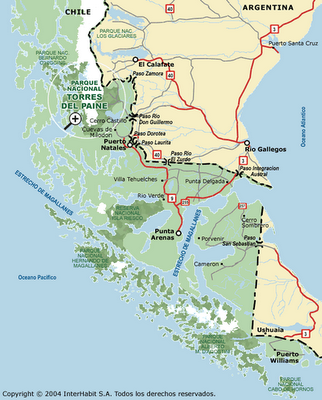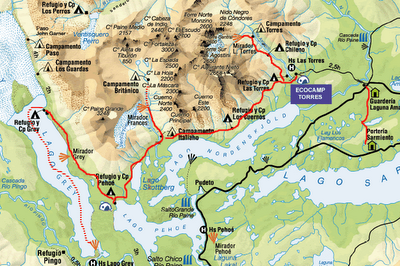After a fairly good night of sleep (interrupted only by the sound of waves crashing on the beach, and at one point, the sounds of Jorge chasing off a couple of other dogs), we woke up refreshed and relaxed. We only had a couple hours of driving left to get back to Santiago, and our flight did not leave until 10pm. So, we were again going to take our time, following the coast through small towns.
We enjoyed a small breakfast at our nice garden picnic table, again attended to by our good doggie friend Jorge. He was again more interested in any attention that we'd give him than any food we'd offer. It was clear that he was looking for a nice home to be a part of.

This point was made crystal clear by his reaction when he saw us packing our bags. His face dropped, and he started rubbing against Julie as if he were an overfriendly cat. When we loaded the bags in the car, he started some desperate begging, last-minute pleas to take him with us. We briefly considered how we could get him through customs, but decided that in this age of national security he probably didn't stand much of a chance. So, we reluctantly jumped in the car, readying ourselves to leave.
And then he jumped in the car, too!

As sad as we were to have to leave him behind, now we had to actively get rid of him. We decided to first have one more run with him on the beach. So we drove a few hundred yards down the road to the public beach, and jumped out, hoping he'd again stay by our sides, and follow us out onto the sand.
He did, and after he ran off to say hi to one of his dog buddies from the previous night, we ran and jumped back in the car. He caught up to us before we got in, and we had to do a pull a little trickery to get in and the doors closed before he could follow us.
We held back emotions as we pulled away. True to his loyal spirit, he chased the car with all of his speed for at least 100 yards down the road before finally giving up. Jorge was a good dog.
We drove on, passing through a few more coastal towns that confirmed we'd found an excellent choice for our last night. We'd initially been considering Horcon, which was recommended on a website as a beautiful, sleepy, fishing village. It was nice, but lacked (at least from what we saw) the same beachfront options that we'd had.
Shortly thereafter, we arrived at the north end of Vina del Mar, which we had visited a couple weeks earlier with the whole group. It really is a beautiful city, and the rocky shores right by the road on the north end of the city were amazing.
After a stop for some real coffee at the same cafe that we'd rested at following our daytrip to Vina, we drove on. We had plans to stop at one more place in Valparaiso, a local artisans market. Nearing the supposed location (as designated in the Lonely Planet book -- which we were beginning to view with a fair amount of skepticism), we pulled up for Chilean metered parking.
No parking meters required. Again, the abundance of labor was clear, as two men helped us to document our arrival time, and confirmed the price of parking. Despite the stated similarities between Valparaiso and San Francisco, the 300 pesos per hour that we paid is far less than a downtown San Francisco parking meter.
We finally found the market, and left only after making a purchase that would test our turista mettle on the return flight. We bought a large piggy bank. Handmade of glazed ceramic, with a body the size of a soccer ball, and sure to aggravate fellow passengers fighting for overhead compartment space. But he was ridiculously cute, and given the name Jorge in honor of our recently abandoned friend.
After a few Coquimbo-like maneuvers dodging pedestrians we made it out of Valparaiso, cruising on the homestretch toward Santiago.
We made it back into town and back to Pablo's apartment, taking a detour to hit the artisan's market at Las Dominicas. I swear, this will be the last mention of artisan's markets. We'd wanted to buy some candies for our labs (people are always bringing back sweets or other delicacies from their various travels).
We repacked our bags, and bought one last authentic Chilean meal before our flight home. Subway - Eat Fresh. We learned that they call the orange cheese at Subway in Chile 'cheddar' instead of 'american'. Yes, sadly, we succumbed to our desires for something from home, and we even guiltily sipped down another sin after stopping at Starbucks. Never underestimate the allure of familiarity (or is it the power of marketing...)
You know how I said to trust your navigator a few posts back? Yeah, you really should. A few bungled directions resulted in us getting to the airport just an hour and a half before departure. Luckily, the car return was a snap:
Them: Tienen problemas?
Us: No, no problemas. (believe it or not, we'd been told after getting the tire fixed at the La Serena Budget rent a car to tell them that everything was fine)
Them: Esta bien.
We wrestled our giant bags up to the check-in desk. We sweated through departing customs (Julie had somehow lost a form which was -- despite the concerning words of the Delta agent -- completely dispensible). We stumbled through the Duty-Free area. We filed on to the plane and delicately balanced the new Jorge above us. And then we collapsed in our seats. We were wiped out.
All in all, it was an amazing trip. We'd been extremely fortunate with the weather, and all plans and accomodations had worked out quite well.
If anyone were to ask what we could have done differently to make it a better trip, there is only one thing that I can think of:
We would not have watched the in-flight movie on the return flight. Truly. Avoid "My Super Ex-girlfriend" at all costs.






































